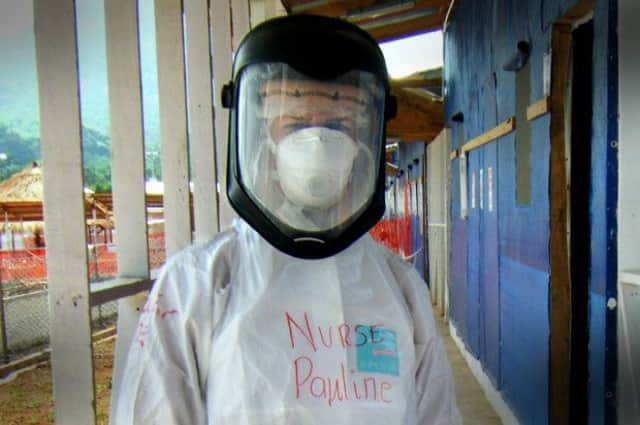Pauline Cafferkey’s journey to Ebola ‘red zone’


They changed her too. As a nine-year-old girl in Fife, the reports inspired her to help others. “The reason I went into nursing was, 30 years ago, when I was a wee girl, I saw the big famine in Ethopia,” she revealed in an interview with Scotland on Sunday last week. “I felt compelled to go and help.”
CONNECT WITH THE SCOTSMAN
• Subscribe to our daily newsletter (requires registration) and get the latest news, sport and business headlines delivered to your inbox every morning
Advertisement
Hide AdAdvertisement
Hide AdA nurse of 16 years, Ms Cafferkey is an associate public health nurse in Blantyre, South Lanarkshire. Along with her work for the NHS in Scotland, the 39-year-old has also worked in Africa, giving her time and expertise to tend to those less fortunate.
“Volunteering in various capacities has been a big part of my life and is now just a normal thing,” she told Scotland on Sunday.
Last month, when the call went out for medical professionals to travel to West Africa to help deal with the Ebola crisis, she was among the first in line.
“None of my friends or family were surprised that I decided to join the NHS response,” she said.
Ms Cafferkey, who grew up in Crossgates, near Dunfermline, was one of 30 NHS volunteers who arrived in Sierra Leone on 23 November to work in specialist hospitals.
Her remit saw her join a group of 14 volunteers with Save the Children, stationed in the highly infectious “red zone” near Sierra Leone’s capital, Freetown. In an emotive diary for Scotland on Sunday, Ms Cafferkey told how one family she had looked after was all but ravaged by the disease. In her third week in Sierra Leone, she was with a woman who was dying, a patient who “didn’t have long.”
As Ms Cafferkey tried to make her comfortable, she saw a young boy at a window, looking, and waved to him. A few minutes later, the woman died.
Advertisement
Hide AdAdvertisement
Hide Ad“I heard the boy crying outside the ward,” she recalled. “When I went to him, he asked if she had died. I said yes. He said she was his mother. He had already lost his father to Ebola, and now he had no parents. I tried to console him, and he said he has a sister who also came to the treatment centre with him and his mother, but he did not know where she was.”
Ms Cafferkey retraced the morning’s events. A young girl had died. On leaving the red zone later that day, she checked the medical notes: it was, tragically, the boy’s sister who had lost her fight.
“His mother had seen her daughter die in the bed across from her that morning and she died a few hours later,” Ms Cafferkey added.
“I informed the psychologist of the young boy and she will offer support. The sad thing is that this is a regular occurrence and we see and hear of whole families being wiped out by this awful disease.”
Despite such difficult situations, Ms Cafferkey seemed at home in Sierra Leone. Looking back on her “nice community nursing job” in Scotland, which seemed “far removed” from the devastating situation in West Africa, she felt she belonged.
“[I] feel like the work I am doing is a normal part of life… at the moment this seems a lot more real,” she said.
Indeed, a fortnight into her time in Sierra Leone, the disease became part of her nights as well as her days, and she wrote of how “the dreams that I do remember always seem to have an Ebola theme, it seems to be all-consuming”.
The danger to Ms Cafferkey and other volunteers was never far from their minds. Every time they passed from the safe green zone into the red zone, she said, they wished one another good luck.
Advertisement
Hide AdAdvertisement
Hide AdIt was a “bizarre” ritual, Ms Cafferkey told Scotland on Sunday, but also “a sobering reminder of what we are doing.”
The personal protective equipment she and others wore while working in the red zone was, she said, an “alien-type suit” that was “horrendous” to get in and out of. “It takes about 20 minutes to dress and 15 minutes to take the suit off at the other end,” she added in her diary.
Describing the suits, on which she wrote “Nurse Pauline” in red marker pen, she said: “They would certainly be beneficial on a cold winter’s night in Scotland but working in them in 30-degree heat is uncomfortable to say the least.
“On the upside, I feel very well-protected. I was unaware that I could sweat so much. When I get to the decontamination area and remove the suit and gloves, there are pools of sweat dripping from me and not a dry hair on my head.
“I feel sorry for the poor patients who have these alien-type people caring for them. Especially so for the young children, who are not only very sick but have these strange creatures with only their eyes visible, trying to make them drink and take medications.”
In her final days in Sierra Leone, Ms Cafferkey expressed delight at the growing number of discharges, with patients clear of Ebola able to take a so-called “happy shower” – a chlorine wash – before re-entering the outside world.
“It does wonders for staff morale, as some of the things we see inside the gates are very unpleasant,” Ms Cafferkey explained.
“It helps us remember the good work we are doing and the reason we are all here.”
Advertisement
Hide AdAdvertisement
Hide AdAs she herself continues to receive treatment for Ebola, it is a sentiment many she cared both with and for will no doubt share.
SCOTSMAN TABLET AND IPHONE APPS